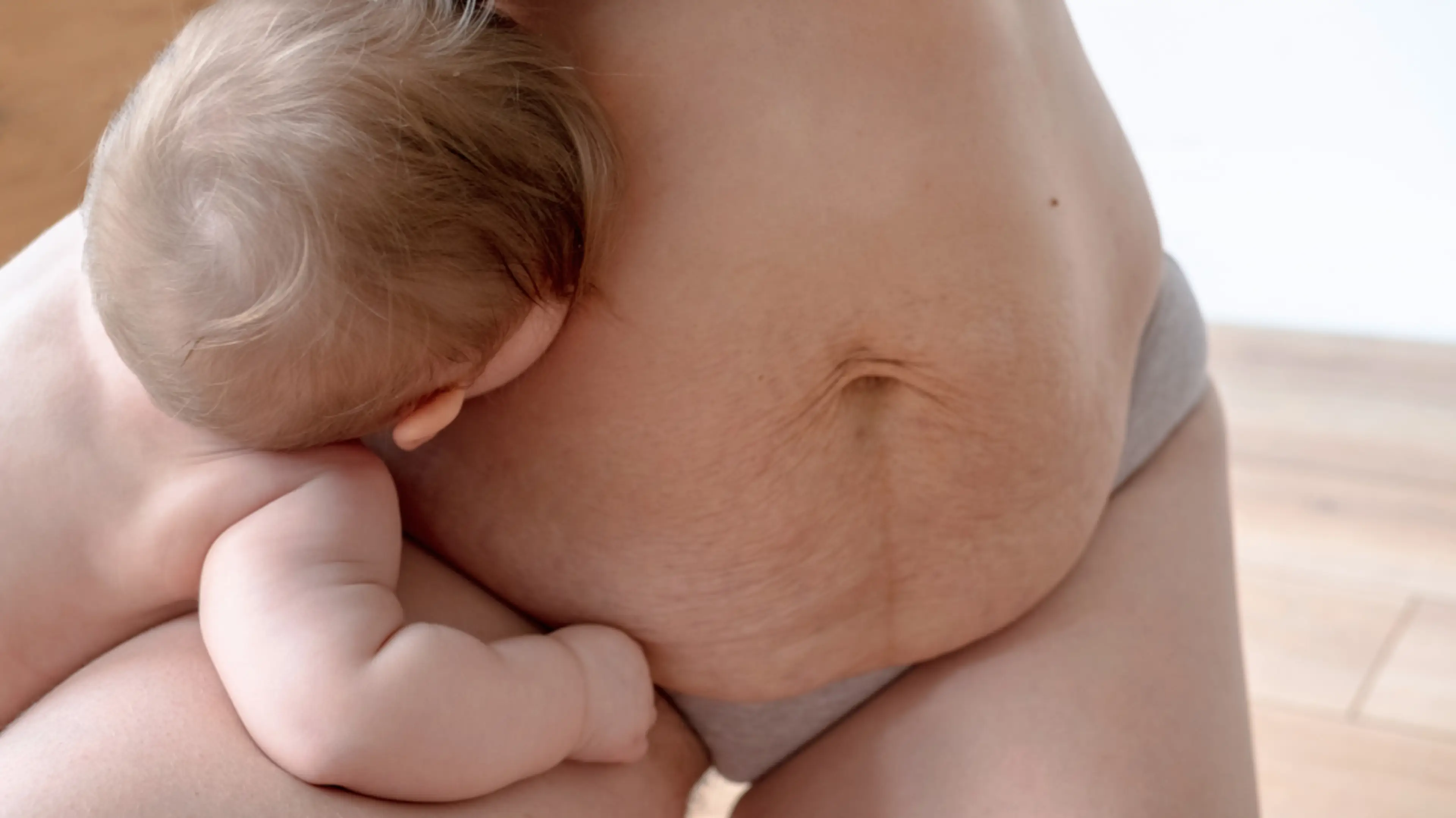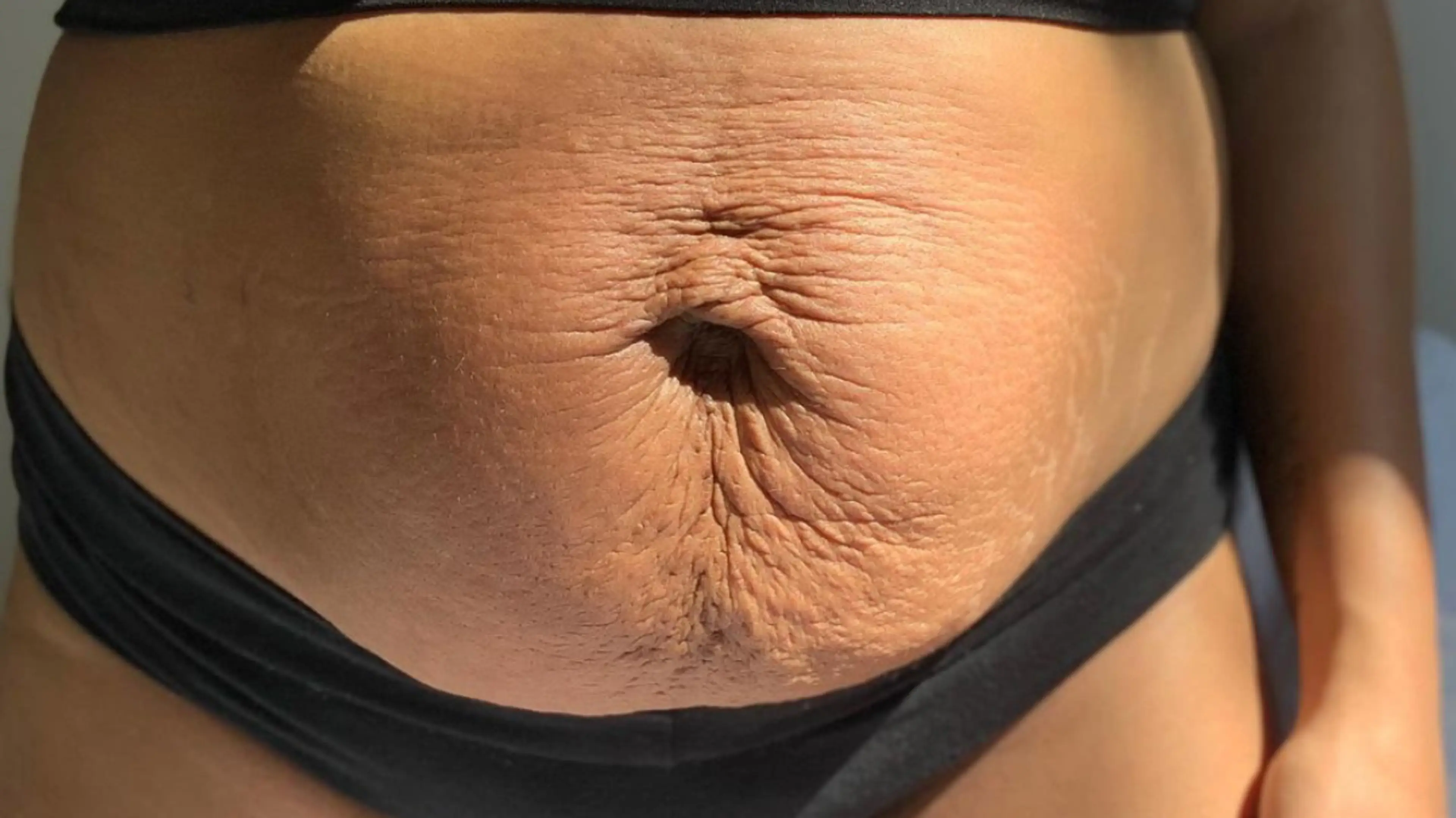Whether you call it a “mom pooch,” “apron belly,” “shelf tummy,” or something else, it’s completely normal for your abdomen to change after giving birth. Lest you forget, you grew a ball of cells into a wiggly person for the better part of a year. Your muscles stretched, your colon basically moved into your chest, and let’s not even talk about what your skin did. The point is, no matter how your baby makes an entrance into the world, your body has to put itself back together again. And depending on your genetics, age, pre-pregnancy fitness, and a whole host of other factors, it maybe (probably) won’t do it in exactly the same way.
If that feels hard to accept, that’s because it is. “Society has put these pressures on women, like, ‘Oh the pregnant body is beautiful,’ but the moment we’re postpartum it's like, ‘Oh, you need to cover that up,’” says Amy Meehan, a physical therapist who practices at Revelle Physical Therapy in Atlanta. “I say, kiss my ass, I just birthed a human and my body is not going to be the same, and we really need to be supporting women in that.”
Embracing my own postpartum stomach area hasn’t been easy. Of course, I’m grateful to my uterus for growing such an exceptional human, and I appreciate my other organs for moving out of the way to make room, but did I immediately love the still-pregnant-looking body I saw in the mirror after giving birth? Absolutely not. Did I desperately hope that in the coming weeks my stomach would settle back into some semblance of the waistline I remembered? You bet. And now that it’s been 3.5 years, do I look down fondly at my lower tummy pooch that never quite went away? Honestly, no, but I’m really trying to, and here’s why you should, too.
There is more to you than a bit of extra stomach fat. Maybe you have no idea what it really took for your body to grow a child. Maybe you need some help making a slight mindset shift. Or maybe you actually have something going on below the surface that could benefit from physical therapy. Either way, reframing how you view yourself, and acknowledging the massive inside-out transformation it takes to bring a baby into existence, can help you sweat the small stuff—like a lingering belly pooch—a little less.
Remember, Your Abdomen Has Been Through a Lot
First, let’s take a minute to really appreciate all your abdomen did to accommodate a growing baby. During pregnancy, as your uterus grows, all your other organs—the liver, stomach, intestines—have to go somewhere, says Meehan. “The diaphragm separates the lung cavity and the abdominal cavity, and acts as an umbrella,” she says. “So what happens is the diaphragm rises and the ribcage expands outwards to make room for all of the other organs and the baby.”
Then there are the abdominal muscles. “The very deepest layer of the abdominal muscles is the transverse abdominis, which is like a big corset muscle that wraps all the way around the belly and connects the midline, called the linea alba, which is a connection point for all the abdominal muscles,” says Meehan.
So, as things start to expand, the ribs go out, the belly gets bigger, and that midline starts to stretch out. The internal and external obliques also start to thin and stretch. Then, you have two bands of muscles in the front of your abdomen (your six-pack abs) that start to separate and expand. This is called diastasis recti, and it's completely normal, says Meehan.
To further the point that your body went through a huge transformation, think about this: after your muscles, connective tissue, and skin have been stretched to the absolute limit—poof!—you give birth and you no longer have anything in that baby-shaped hole in your abdomen. “You suddenly lose all this stuff taking up that extra space, and now you have this tissue that’s pretty stretched out, and muscles that are in an environment where they are not being held at that full stretch anymore,” says Rebecca Maidansky, a physical therapist and founder of Lady Bird PT in Austin, Texas.
For some people, it just takes time for things to go back into place, and for others, the changes may not go away completely. One complicating factor? Diastasis recti, which can cause the stomach to protrude a bit, says Maidansky, “but there are plenty of people that have that visual appearance without diastasis recti, because it can also happen as a result of connective tissue or fatty tissue.”
The C-section shelf or pooch is another common sticking point. A C-section is major abdominal surgery, where your doctor cuts through skin, fascia, muscles, and your uterus. “That tissue that’s already been stretched and strained is then further weakened and affected by surgery, “ says Maidansky. “Then, when the sutures come out, the scar tissue isn’t as stretchy as other tissue, so we get a stiffening around the scar.”
Imagine your stomach is a sheet, hanging down straight. A scar is basically someone coming up behind that sheet and pinching and pulling it back. “So you get this droopiness or pulling above that hinge that creates a shelf-like appearance,” says Maidansky.
Depending on genetics and collagen tissue makeup, you might even see stretch marks, extra skin that sags, and a softness in the abdomen no matter how you gave birth, says Maidansky. “That’s totally normal and not a sign that anything is wrong,” she says. All of that is to say that there is a really wide range of what is a normal, typical postpartum body. “Everybody’s body composition, even before getting pregnant, is different,” says Meehan. “So, realistically, your body composition is going to be very different after, and you cannot compare yourself to other people.”
Read Next: We Need to Talk About Postpartum Body Changes
How to Shift Your Thinking About Your Mom Pooch
When Amylia Ryan, 32, got pregnant with her first child, she already felt nervous about how pregnancy would change her body. “I have always been very body conscious, and I grew up surrounded by a lot of negative body-related language,” she says. So, when she did give birth, the reaction to her postpartum stomach wasn’t exactly glowing. “I don’t want to use the word “horrified,” but that’s pretty close.”
Since then, she’s been trying to come to terms with her new body. “My road to acceptance has been very long, and very roller-coaster-y. There are some days where I’m very accepting of it, and some days I’m absolutely not.”
If that sounds familiar, you’re not alone. Body image is a lifelong journey, says Monique Bellefleur, a licensed mental health counselor specializing in perinatal mood disorders, because we’re constantly having to renegotiate our relationship with it. “Going through pregnancy and the postpartum period is one of the most major changes you’ll probably ever experience, so it’s very common for people to have some trouble adjusting to feeling good about their postpartum appearance.”
Despite that, you don’t have to get stuck in a negative headspace about your mom pooch. Here are some ways to shift your mindset, so you can see all of you, including the jiggly bits, in a more positive light.
Know that it’s okay to not love your body every second of every day
It’s tough to ignore the societal message that your postpartum belly needs to fit into your old pants. Even worse? When you feel bad about your body, but then you also feel guilty for not embracing your new self like an A-plus member of the body positivity movement.
“That can feel invalidating,” says Bellefleur. Instead, she says to try shifting your inner dialogue to “I’m having a hard time with my body image right now, and I can still work to appreciate my body.”
That kind of reframing can help you reflect on aspects of your body that you are proud of and you do appreciate, which leads us to the next point.
Try to give yourself grace and compassion
Think back to the description of what your body did to grow a human and bring it into the world. Everything had a job, and each muscle, organ, and cell did its part perfectly. “Try to appreciate your body for what it has done, and what it is doing—your body did some really hard work to grow and birth the baby, and you’re still taking care of a baby,” says Bellefleur. “Try to remember and appreciate how amazing your body is and what it has done for you, and offer yourself a lot of grace and compassion,” she says.
Focus on taking care of your body
A more actionable way to stop negative body talk in its tracks is to focus on self-care and treating your body well. “That might mean giving it enough nourishment, it might mean allowing it to move in a way that feels good and comfortable and gentle, like taking walks with the stroller or doing some light stretching,” says Bellefleur. “It could also mean taking a really nice shower or bath, choosing your favorite scented lotion, and allowing yourself to really enjoy the experience and be present,” she says.
For Ryan, self-care means paying attention to her gut health. “I have IBS, and I’ve noticed if I start to feel more bloated, I blame the shape of my belly, like, it’s because I’m too big for the pants I’m wearing and it’s giving me digestive issues.”
While she can’t control every flare-up, focusing on how she feels rather than how she looks has been helpful. “If I feel good internally, I feel better about myself externally,” she says.
Wear comfortable clothes
Maybe the best piece of advice is to buy the comfortable pants, invest in the luxurious loungewear, and just embrace your comfy clothing era.
If you’re wearing pants that are too tight, every time you feel that discomfort, it’s going to trigger you to think about your body,” says Bellefleur. “A lot of times your brain is interpreting that as there is something wrong with your body, and you need to change this so you feel more comfortable,” she says. “Yet, we can choose to feel more comfortable without changing our bodies.”
Ryan says she had to learn that lesson the hard way. After investing in countless shapewear products and being disappointed and extremely uncomfortable with all of them, she realized it was better for her physical and mental health to let her body breathe. “Just save the money and save your sanity,” she says.
Work with a physical therapist
In some cases, you may want to improve the functionality of your abdominal muscles (and that may, in turn, improve the appearance of your abs). Working with a pelvic floor therapist or physical therapist will allow them to identify if there is an issue, like diastasis recti, and then provide exercises and stretches to help get those muscles talking to each other again.
It’s also fine if you do want to improve the appearance of your tummy, says Meehan, who often refers people to an esthetician or plastic surgeon to talk about treatment options. You can try lasers, microneedling, collagen boosters—anything you can do for the skin on your face, you can do for the skin on your belly, she says. “We have got to stop telling women they just have to deal with it.” The key is to figure out what you want and need, not what someone else is telling you that you should do.
Reach out to a mental health professional
If you’re having a hard time with your body image during pregnancy or postpartum, it might be a good idea to talk with a mental health professional. Negative thoughts that get in the way of your daily functioning or patterns of disordered eating, should definitely be addressed with somebody that specializes in body image issues, says Bellefleur. “This will give you a safe space to speak about it.”
No matter where you are on your journey to self-acceptance, learning to appreciate what your abdomen did during pregnancy can soften how you view yourself. As one popular family therapist wrote on Instagram, the changes are your body’s way of remembering being pregnant. When I think about it that way, it really does feel like a beautiful thing—and I’m finally letting that sink in.









